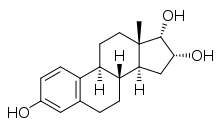17α-Epiestriol
17α-Epiestriol, or simply 17-epiestriol, also known as 16α-hydroxy-17α-estradiol or estra-1,3,5(10)-triene-3,16α,17α-triol, is a minor and weak endogenous estrogen, and the 17α-epimer of estriol (which is 16α-hydroxy-17β-estradiol).[1][2][3] It is formed from 16α-hydroxyestrone.[4][5] In contrast to other endogenous estrogens like estradiol, 17α-epiestriol is a selective agonist of the ERβ.[6] It is described as a relatively weak estrogen, which is in accordance with its relatively low affinity for the ERα.[7] 17α-Epiestriol has been found to be approximately 400-fold more potent than estradiol in inhibiting tumor necrosis factor α (TNFα)-induced vascular cell adhesion molecule 1 (VCAM-1) expression in vitro.[8]
| Compound | PR | AR | ER | GR | MR | SHBG | CBG | ||
|---|---|---|---|---|---|---|---|---|---|
| Estradiol | 2.6 | 7.9 | 100 | 0.6 | 0.13 | 8.7 | <0.1 | ||
| Alfatradiol | <1 | <1 | 15 | <1 | <1 | ? | ? | ||
| Estriol | <1 | <1 | 15 | <1 | <1 | ? | ? | ||
| 16β-Epiestriol | <1 | <1 | 20 | <1 | <1 | ? | ? | ||
| 17α-Epiestriol | <1 | <1 | 31 | <1 | <1 | ? | ? | ||
| Values are percentages (%). Reference ligands (100%) were progesterone for the PR, testosterone for the AR, E2 for the ER, DEXA for the GR, aldosterone for the MR, DHT for SHBG, and cortisol for CBG. | |||||||||
 | |
| Names | |
|---|---|
| IUPAC name
(1S,10R,11S,13R,14S,15S)-15-methyltetracyclo[8.7.0.0²,⁷.0¹¹,¹⁵]heptadeca-2,4,6-triene-5,13,14-triol | |
| Other names
17-Epiestriol; 16α-Hydroxy-17α-estradiol; Estra-1,3,5(10)-triene-3,16α,17α-triol; 3,16α,17α-Trihydroxy-1,3,5(10)-estratriene | |
| Identifiers | |
CAS Number |
|
3D model (JSmol) |
|
| ChEBI | |
| ChEMBL | |
| ChemSpider | |
| DrugBank | |
PubChem CID |
|
| UNII | |
InChI
| |
SMILES
| |
| Properties | |
Chemical formula |
C18H24O3 |
| Molar mass | 288.38136 g/mol |
Except where otherwise noted, data are given for materials in their standard state (at 25 °C [77 °F], 100 kPa). | |
| Infobox references | |
References
- Tewari AK (5 April 2013). Prostate Cancer: A Comprehensive Perspective. Springer Science & Business Media. pp. 373–. ISBN 978-1-4471-2864-9.
- Labhart A (6 December 2012). Clinical Endocrinology: Theory and Practice. Springer Science & Business Media. pp. 522–. ISBN 978-3-642-96158-8.
- Assali NS (3 September 2013). The Maternal Organism. Elsevier. pp. 341–. ISBN 978-1-4832-6380-9.
- Von Euler US (2 December 2012). Comparative Endocrinology. Elsevier Science. pp. 135–. ISBN 978-0-323-14609-8.
- Tietz NW (1 August 1976). Fundamentals of clinical chemistry. Saunders. p. 773. ISBN 978-0-7216-8866-4.
- Sherbet GV (26 July 2013). Therapeutic Strategies in Cancer Biology and Pathology. Elsevier. pp. 83–. ISBN 978-0-12-416590-8.
- Dorfman RI (22 October 2013). Steroidal Activity in Experimental Animals and Man. Elsevier Science. pp. 13–. ISBN 978-1-4832-7299-3.
- Mukherjee TK, Nathan L, Dinh H, Reddy ST, Chaudhuri G (April 2003). "17-epiestriol, an estrogen metabolite, is more potent than estradiol in inhibiting vascular cell adhesion molecule 1 (VCAM-1) mRNA expression". The Journal of Biological Chemistry. 278 (14): 11746–52. doi:10.1074/jbc.M207800200. PMID 12547825.
- Raynaud, J.P.; Ojasoo, T.; Bouton, M.M.; Philibert, D. (1979). "Receptor Binding as a Tool in the Development of New Bioactive Steroids": 169–214. doi:10.1016/B978-0-12-060308-4.50010-X. Cite journal requires
|journal=(help) - Ojasoo T, Raynaud JP (November 1978). "Unique steroid congeners for receptor studies". Cancer Research. 38 (11 Pt 2): 4186–98. PMID 359134.
- Ojasoo T, Delettré J, Mornon JP, Turpin-VanDycke C, Raynaud JP (1987). "Towards the mapping of the progesterone and androgen receptors". Journal of Steroid Biochemistry. 27 (1–3): 255–69. doi:10.1016/0022-4731(87)90317-7. PMID 3695484.
- Raynaud JP, Bouton MM, Moguilewsky M, Ojasoo T, Philibert D, Beck G, Labrie F, Mornon JP (January 1980). "Steroid hormone receptors and pharmacology". Journal of Steroid Biochemistry. 12: 143–57. doi:10.1016/0022-4731(80)90264-2. PMID 7421203.
This article is issued from
Wikipedia.
The text is licensed under Creative
Commons - Attribution - Sharealike.
Additional terms may apply for the media files.